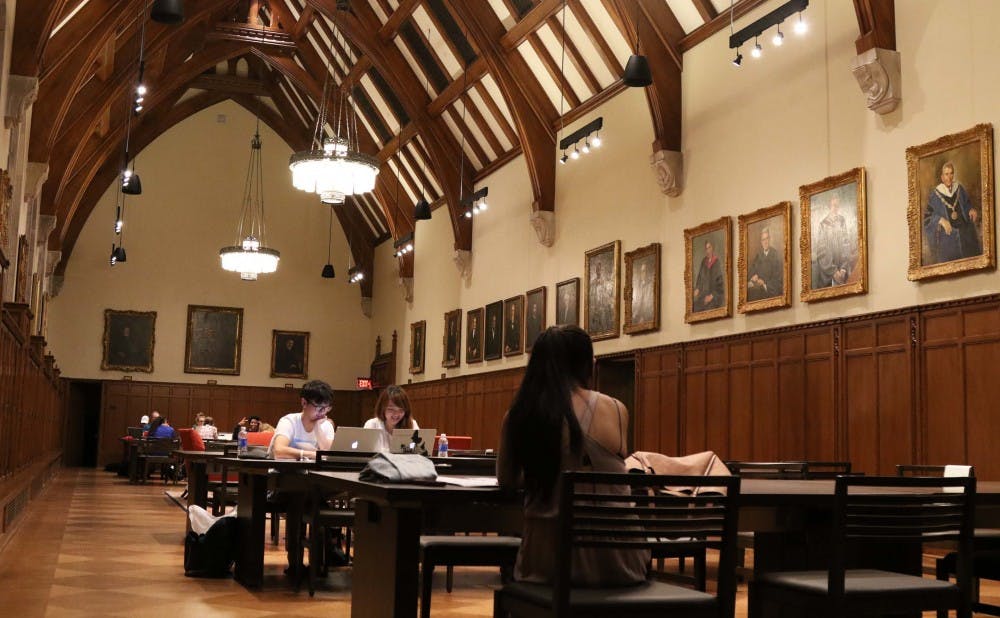The David M. Rubenstein Rare Book and Manuscript Library reopened Monday—marking the completion of renovations that transformed the building into a state-of-the-art research facility.
The approximately $60 million renovations to the 1928 and 1948 portions of Rubenstein—the original West Campus library structure—included adding more event spaces, study rooms, technology and new exhibits. Construction began in late 2012 in the final phase of the Perkins Project, an initiative that originated in 2000 to improve the design and function of the Perkins Library complex. Rubenstein will now be a better space for students, faculty and visiting researchers to utilize, said Aaron Welborn, director of communications for the University libraries, during a recent tour of the renovated space.
“This is the kind of space we’ve needed for years and we finally got it,” Welborn said.
Updated exhibit spaces on the first floor—such as the Mary Duke Biddle Rare Book Room—will be the highlights of Rubenstein, Welborn explained. Old exhibit cases were replaced in these areas to show off some of Rubenstein’s special collections, such as a history of anatomy textbooks, he noted.
Other aspects of the renovated first floor include exhibit spaces that will highlight student and faculty research and a gallery focused primarily on photography and other kinds of flat media, explained David Pavelich, head of research services of Rubenstein.
In addition, the Michael and Karen Stone Family Gallery will display the Rubenstein’s extremely rare artifacts such as the The Bay Psalm Book—the first book printed in what is now the United States—and English writer Virginia Woolf’s writing desk, Pavelich said.
“You can see all of these foundational documents in a way that you can’t necessarily do in other places,” Welborn said. “It’s a personal interaction with history.”
Several students voiced their approval of the completed renovations.
“We’ve been waiting for it for a long time,” senior Rachel Anderson said. “It’s pretty thrilling to see it reopened.”
Senior Liz Colavita agreed, noting that she is excited to have the main entrance to the library finished in time for her final year on campus.
Rubenstein will host an open house on Sept. 10 to show off the new space. In addition to food and giveaways, library staff will give tours of the new spaces.
Another area of interest on the first floor is a new event space—able to hold about 90 people—that was added near the front of the library and will be used to host an increased number of programs, Pavelich explained.
“We’ve been wanting a space like this that’s right on the main quad, and I think it will be a very popular room,” he said.
The library’s entrance was transformed to make it easier for visitors to enter the building closer to the bus stop, and students will be able to access Perkins Library by going through an exhibit gallery. The front entrance to the library now also features a plaza where people can gather, Welborn explained.
New features for teaching—such as projectors that can display images of physical artifacts onto screens—were included in the renovations, Welborn said. He added that students in classes that do research in the library’s archival collection will be able to use these as well. Pavelich said that the library now boasts upgraded teaching spaces as well as seminar rooms that can hold about 10 people. Three group study rooms are now available for students and include bigger tables and more power outlets.
Updated technology includes better climate control to maintain the ideal temperature and humidity for preserving books, Welborn explained. New deep cold storage rooms will store color photography. He added that an improved exhibit prep area will allow employees to better prepare the library’s many exhibits.
The renovations will also be useful for visiting scholars, Welborn said. These researchers will be able to use the upper floors of the library—which previously served as offices for the political science department—as study spaces.
“Our researchers come from all over the world,” he said. “This will be something they remember as Duke, they’ll remember this space.”
The renovations were not without challenges, however. Welborn explained that the old steel stacks—which were part of the skeletal structure of the building—had to be replaced. Architects found a way to core the building from the top down and reinforce it with steel beams, he said. In addition, Welborn noted that the renovations came at a time when students were already voicing complaints about the number of construction projects on campus.
Welborn added that he is excited to welcome students back into the building and that he prefers when the library is full. One of the more student-friendly aspects of the new Rubenstein will likely be the Gothic Reading Room on the second floor, which features modified study space along with portraits of many University figures.
Get The Chronicle straight to your inbox
Sign up for our weekly newsletter. Cancel at any time.
“We want people to come study and use this place and be inspired,” he explained.
Amrith Ramkumar contributed reporting.

